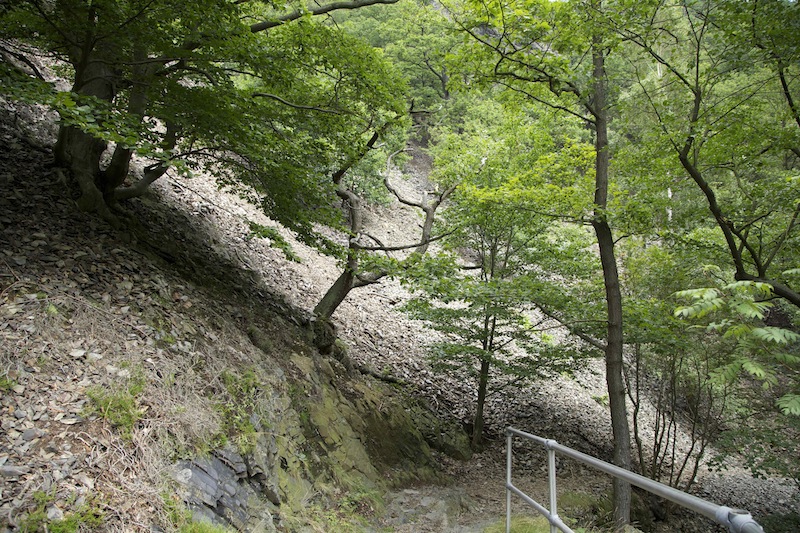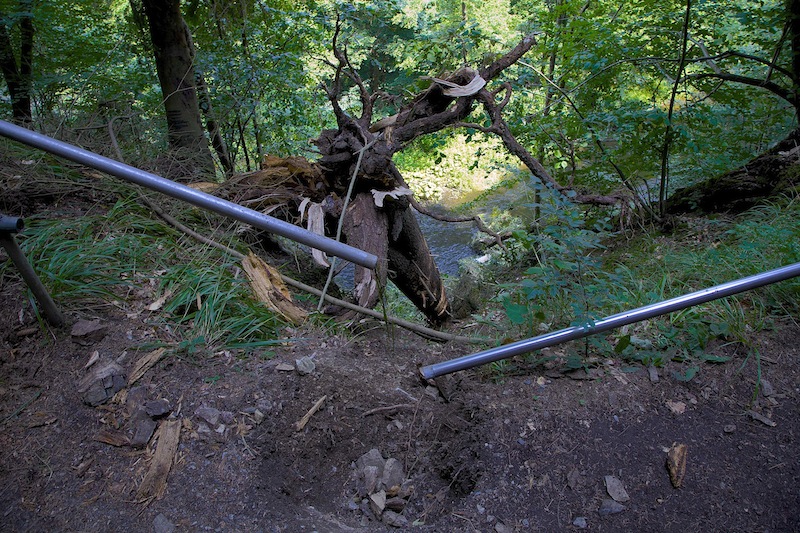The Destructive Side Of Nature – Landslides In The Bode Valley
The Bode Valley near Thale in the German Harz Mountains is famous for its prominent visitors like Johann Wolfgang Goethe. It’s the sometimes called “German Grand Canyon” due to it’s unparalleled wilderness. At Goethe’s times there wasn’t a trail leading through the whole valley. Therfore he could only have a glimpse into the steep and dangerous terrain. What he saw might have triggered his imagination for writing his famous “Faust”. Sharp rocks, primeval forest, a wild river, dark holes of little caves and unpredictable weather. Close to the Bode valley is the notorious “Hexentanzplatz.” perhaps a former cultsite situated on a cliff high above the valley. On the other side is another rock, which is an old pagan cult site, the “Rosstrappe”.
Even today with the river Bode tamed and hundreds of tourists walking through every day its a place of both extraordinary beauty and an intimidating and dangerous wilderness.
However over the last years the terrain seems to really show the destrutive side of nature: 2010 a landslide buried the trail, which leads from the valley to the well known Rosstrappe view-point. And over the last seasons a lot is happening on the other side of the river.
Authorities are already thinking about closing the popular trail because they are afraid hikers could be in danger due to the landslides and the imminent danger of falling rocks as a local from the city Thale told me.
On July 27, I took a hike through this wilderness and made as much pictures as possible since I do not know when the chances to go there are gone.
It was a warm and humid day and the first thing you feel when you enter the Bode valley from the upper side from the village of Tresenburg is that it’s suddenly getting colder and more humid. The valley literally has a climate of its own. It’s like entering a cellar.
The moisture is everywhere, in some places water is pouring directly out of the rocks. Further down you feel that you become a witness of a war of the elements. Stones have damaged trees, trees are sometimes felt and shooting down into the abyss. It’s becoming more and more an awe inspiring area.
The question is what’s going on beyond the normal change and the given instability of the rock face?
First of all we need to keep in mind that erosion is a normal process in these mountains. Compared to the alps the Harz region is a very old mountain region. You can find everywhere fields of huge blocks of rock. Actually these mountains are shrinking.
However something seems to happen.
It’s worth to mention that mudslides and landslides are more often reported over the last years in Europe. Last year a tragic accident happened on the island of Rügen in the Baltic Sea when one of famous white chalk rocks crashed down. We hear every year from many mudslides coming down in the alpine regions. Getting closer to Thale on the trail, which is going up and down in the valley you get the impression that parts of the rockface collapsed and any time more debris might come down. Big stones in the middle of the path are visible reminders of the warning sign when you enter the valley.
There might be several reasions involved for the increasing instability inside the valley as in some other areas. Of course climate change might be worth to consider if we think of the usual suspects. In the alps we know about the problems when the so-called permafrost is melting away, which keeps the rocks together. When temperatures rise the structure becomes less solid. The key role of water might be important when we think of the increasing number of heavy rainfall during summer. On the other side we have seen long dry periods and some very cold winters.All these factors might put the mountain under a bigger stress – it’s up to the scientists to come up with answers what’s really going on here.
We can only hope that we can still enjoy the wild beauty of the Bode Valley in the Harz Mountains also in the future.
Not far from the beginning of the trail a tree destroyed the protection rail and hit a hole in the middle of the way.
Further down a huge landslide must have happened. The trail crosses a field of stones. It’s remarkable how some trees survived the event.
Not far away, big trees have coming down and creating the image of a battle zone of mythical giants. Wild weather with severe storms happens a lot in the Harz Mountains. The so-called “Walpurgis Night”, the witches sabbat, might have been inspired by extreme weather conditions.
If you hear something you better be fast. This one is not the only big stone which hit the trail.







Nevertheless it’s the stunning beauty of the Bode valley which lasts in the memory. If you are careful and follow some rules (don’t leave the trail and watch your steps – you might endanger other hikers otherwise) and the advice of the mountain rescue service the Harz Mountain’s are one of Germany’s most fantastic areas for a trip or vacation. It’s situated in the middle of the country and can be easily reached both from Berlin and Hamburg. On weekends there is a direct-train from Berlin Central to Thale and to Werningerode, where the steam train leaves for the Brocken-Mountain.
http://youtu.be/hDROXgxesmo




